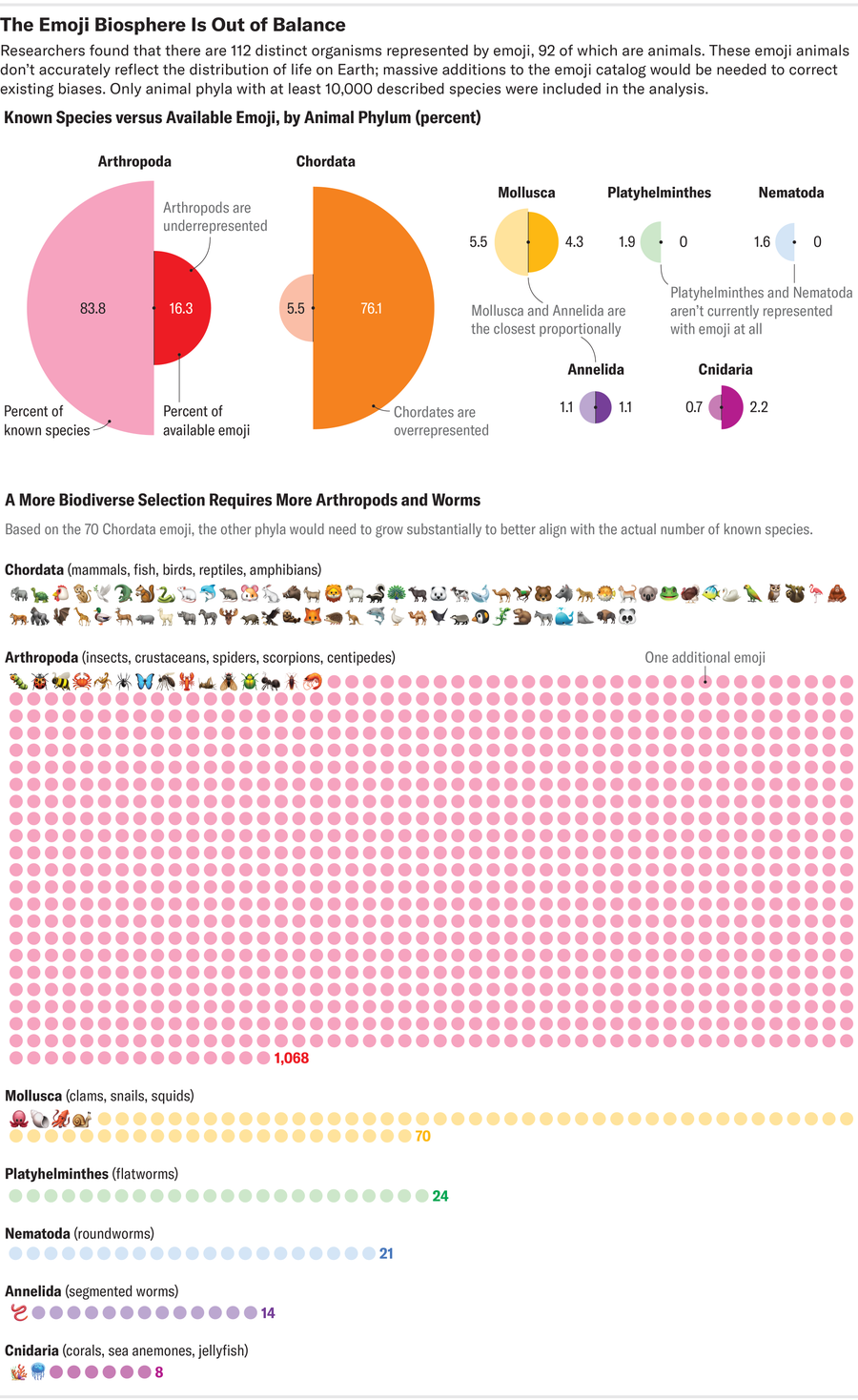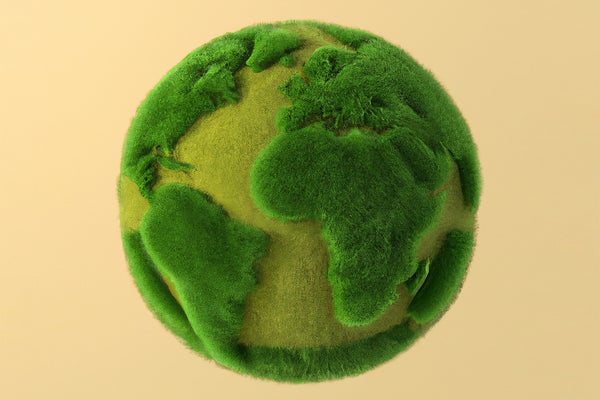Ecologists and biologists commonly conduct surveys of the plants, fungi and animals in the environment they study. It’s less common, however, for that environment to be the virtual emojisphere. Emoji, the cutesy digital characters that have become their own mode of communication in text messages and online, are chock-full of representations of the natural world. Yet those representations are seriously skewed, according to a study published recently in the journal iScience.
In an analysis of Emojipedia, a comprehensive emoji catalog, researchers have found that the emoji tree of life is lopsided: It entirely lacks a few big branches, such as flatworms and echinoderms (the group that includes starfish), and heavily favors vertebrate animals over all other groups of life-forms. And the entire kingdoms of plants and fungi are barely featured at all; fungi only have a single representative toadstool. This type of partiality, termed taxonomic bias, isn’t unique. Humans have a well-known tendency to focus on and favor charismatic megafauna over other organisms. Yet the study authors—all life scientists—suggest that the large gaps in emoji biodiversity could be hampering digital communication about conservation and biology.
On public-facing social media platforms and even in chats among scientists, limited emoji offerings sometimes make it difficult to put together a quick and legible message, says study co-author Francesco Ficetola, an animal biology professor at the University of Milan in Italy. Biodiversity loss is an international issue, and conservation actions need to transcend borders and language barriers, he says. But “trying to communicate about biodiversity is difficult for us because the languages and cultures are different,” Ficetola adds. “Any tool, including emojis, that improves understanding and connection is fundamental.”
On supporting science journalism
If you're enjoying this article, consider supporting our award-winning journalism by subscribing. By purchasing a subscription you are helping to ensure the future of impactful stories about the discoveries and ideas shaping our world today.
It’s easy to dismiss emoji biodiversity as trivial—especially when we’re in an IRL biodiversity crisis. Emoji have become an increasingly large part of human communication, however, and it’s worth examining what has and hasn’t yet made it into our ever expanding pixelated lexicon, says Sanjaya Wijeratne, a computer scientist at the video game publisher Nexon America, who has researched emoji meaning and use but was not involved in the new study. “The paper asks a valid question,” he says. Wijeratne points to published research that suggests that including emoji in social media posts can increase positive engagement with those posts (by about 70 percent, in some cases). A relevant emoji could help conservation researchers or organizations promote awareness of certain species online, Wijeratne and Ficetola both suggest.

So far, however, there hasn’t yet been any formal research on emoji use and online engagement related to conservation—a limitation highlighted within the study. And emoji are not free to produce, so new characters must be rigorously evaluated, says Jennifer 8. Lee, a current member and former vice chair of the nonprofit Unicode Consortium’s Emoji Subcommittee, which is responsible for shaping emoji policies. Lee also co-founded Emojination, an organization that advocates for more inclusive and representative emoji.
Lee has been directly involved in expanding the emoji catalog many times over. She was instrumental in getting the dumpling emoji added to the library. In her roles with the subcommittee and Emojination, Lee has also helped expand the emoji species list. She says she assisted in getting approval for the earthworm, cockroach, beaver, sloth, llama, fly, mosquito and hippopotamus emoji.
Each of these additions had to be carefully considered in a cost-benefit analysis conducted by the Unicode subcommittee, which has strict guidelines for the creation of new emoji characters. The potential costs of added emoji includes computer server and electronic device storage space, keyboard clutter and payment to designers. Emoji are considered a font within our phones. More emoji characters make the font more cumbersome, and past a certain point, usership and accessibility might go down, Lee explains. For example, if cheaper phones have less storage space and can’t accommodate the whole emoji library, or if finding a particular emoji requires scrolling through too many options, then fewer people will be able to use the tool at all.
There are also more philosophical questions at play. Though delighted by the study, Richard Ladle, a professor of conservation science at the Federal University of Alagoas in Brazil, isn’t convinced that we need more biodiverse emoji or that more emoji options would boost conservation discussions. Ladle researches conservation culturomics, the study of human-nature interactions in the digital world. “Emojis are a fascinating thing to study and may give us some insights into peoples’ relationships with nature,” he says. But in his view, the icons are more a reflection of people’s cultural values and online conversations than a determiner of them.
Outside of biology, people often use nature emoji because of their indirect meanings. Animal emoji, especially, carry secondary connotations that can be positive or negative (think the butterfly as a symbol of beauty and freedom versus the cockroach as a symbol of “yuck”). It’s quite possible, Ladle says, that expanding the emoji biosphere could lead to more people using animals to communicate negative ideas. “You can imagine a dung beetle emoji might become a pejorative,” he says.
Ficetola has no illusions that every species should have its cartoon debut. “It’s not possible to have one million emojis,” he says. “That would make everything meaningless because emojis are for fast communication.” Yet he imagines that, with the input of scientists, emoji could better reflect our reality and make biology more legible to more people.
In recent years big strides have already been made in emoji biodiversity. The study points out that the number of animal taxa represented by emoji more than doubled between 2015 and 2022, which was a pleasant surprise for Ficetola. “My personal feeling is that we have a better understanding of biodiversity now,” he says. “The idea that biodiversity is more than just the panda and the lion is spreading through society,” emoji included. But still, he adds, “we can always do better.”
Ficetola and his colleagues make a few suggestions for where the emoji committee might want to start. A tardigrade (water bear), starfish and flatworm emoji would grant much more coverage to the breadth of animal biodiversity, they write in the study, while also bringing visibility to important organisms that are often hidden from public view. “Maybe just seeing an image of something strange like a tardigrade could increase awareness and public understand that our planet is much more complex than we often assume,” Ficetola says.
Yet Lee, one of the Unicode arbiters, doesn’t envision a likely future for these suggestions, which lack the often-necessary elements of cultural relevance and popular double entendre. Although she even advocated for a starfish emoji in the recent past, online interest and potential uses were too limited to push it through. “Starfish, I tried,” she says. “And it’s pretty, but that’s it.”
Perhaps, when it comes to emoji, communicating the complexity of the web of life is too grand a goal. But ↗ for the ☽, and maybe you'll ✈ among the ☆☆☆ (or ☆⬺).
A version of this article entitled “Emoji Kingdom” was adapted for inclusion in the March 2024 issue of Scientific American.
